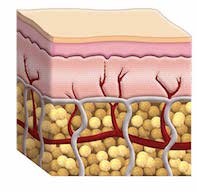A white lesion on the penis
Test your diagnostic skills in our regular dermatology quiz. What is this lesion and how should it be managed?
Case presentation
A 3-year-old boy presents with a white lesion on his penis associated with dysuria (Figure 1). The lesion is itchy and painful and has been present for four months. He was previously able to retract the foreskin easily but this has become increasingly painful.
Differential diagnoses
Conditions to include among the differential diagnoses for a child of this age include the following.
- Fixed drug eruption. This adverse reaction to an ingested medication generally occurs within 12 to 24 hours of ingestion but can occur as soon as one hour after exposure. A fixed drug eruption affecting the genital region is associated with swelling and erythema and sometimes with blistering of the penis and scrotum (Figure 2). Itch can also occur. There may be dysuria, as well as urinary retention due to pain and burning. The lesions are fixed in location and appear as well demarcated plaques that are dark brown or red in colour. The eruption worsens with continued exposure to the medication but resolves within two weeks of cessation. It would be unusual for a fixed drug eruption to last four months, although if it is caused by a medication that is being given continuously (e.g. a sulfa antibiotic being taken by a child for a recurrent urinary tract infection) then the rash may become chronic. Fixed drug eruptions may be confined to the genital area in boys and girls; other commonly affected areas include the trunk, legs, arms and lips.
- Contact dermatitis. Irritant nappy dermatitis is common in babies and young children, particularly in the first two years of life, as a result of a multitude of factors associated with nappy use. This leads to a rash of erythematous papules or patches and plaques that are also oedematous. Many 3-year-old children are no longer wearing day nappies but a proportion are still wearing night nappies – this point will likely not be appreciated unless the clinician enquires about it. It is unlikely to be the diagnosis for the boy described above because the rash tends to encompass a much larger surface area and to be more confluent. Contact dermatitis would be expected to affect the groin, buttocks and perianal area, and not to be isolated to the glans of the penis.
- Lichen planus. This autoimmune inflammatory condition typically presents in adults and is rare in children. The lesions appear as raised flat plaques, purple to brown in colour, which may be grouped or dispersed. They tend to be itchy. Lichen planus is exceptionally rare in children and it is very unlikely to be the correct diagnosis in this case.
- Candidiasis. Thrush is less common in toddlers than babies. It appears as a deep red rash of the groin and buttock area with associated oedema, weeping and scaling. Satellite pustules are sometimes apparent on the edges of the rash, and these can crust over. Thrush would not typically present as a white plaque of the glans. If there is any genital involvement then it is usually the scrotum and penile shaft that are inflamed.
- Psoriasis. This common inflammatory skin condition affects the genitals in about 10% of children who suffer from it. Children usually have a history of psoriasis as an infant (such as a nappy rash or cradle cap), and there may be a family history of psoriasis. The lesions are typically well-demarcated erythematous plaques with scale, and they are characteristically itchy rather than painful (Figure 3). Although this boy’s lesion could be representative of psoriasis, phimosis and change of skin texture is not consistent with the diagnosis. Usually there would be additional clues for psoriasis in other areas of a child’s skin, such as the knees, elbows, nails, natal cleft, perianal area and scalp.
- Lichen sclerosus. This is the correct diagnosis. Lichen sclerosus is an autoimmune condition that almost always affects the genital region. Lichen sclerosus occurs in males of all ages but only those who are uncircumcised. The lesions are confined to the glans and the prepuce, only rarely affecting the shaft and never affecting the scrotum or perianal area. Lichen sclerosus results in recurrent balanitis and, as a result of the inflammation and scarring process, there can be the appearance of pruritic white plaques on the glans, blistering, meatal narrowing and tightening of the foreskin. Untreated, it can lead to phimosis and difficulty urinating. The lesions of lichen sclerosus in boys would not typically be erythematous unless superinfected. It is a skin condition that is classically white in appearance; all other conditions affecting the glans and foreskin in children tend to be red rather than white.
Investigations
Lichen sclerosus in children is diagnosed clinically. A biopsy can be performed when the diagnosis is unclear, but this is rare in children.
Management
Lichen sclerosus in boys is treated with daily potent topical corticosteroids initially to induce remission of symptoms and inflammation. This normally takes several months. Once this has been achieved, control is usually maintained with a lower potency topical corticosteroid.
It is important to commence treatment early because there is a risk of permanent scarring and dysfunction of the penis if the inflammation continues. In adults, the risk of squamous cell carcinoma in untreated cases is up to 4%;1 however, the risk in treated patients is much lower and negligible in children. In some boys circumcision is required, especially if phimosis of the prepuce occurs and is not reversed with topical corticosteroids. Circumcision will produce a cure in most cases but topical treatment may be sufficiently effective that surgery can be avoided. Lichen sclerosus is relatively rare and sometimes difficult to manage, so involvement of a dermatologist is recommended.
Competing interests: None.
Reference
- Nasca MR, Innocenzi D, Micali G. Penile cancer among patients with genital lichen sclerosus. J Am Acad Dermatol 1999; 41: 911-914.

